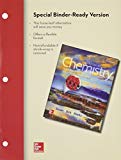
Concept explainers
(a)
Interpretation:
Whether
(a)
Explanation of Solution
Oxygen is produced by the following reaction:
According to the reaction,
The molar mass of
When
So,
(b)
Interpretation:
Whether the partial pressure of water at at
(b)
Explanation of Solution
When
So, the partial pressure of water at
(c)
Interpretation:
Whether the partial pressure of oxygen is
(c)
Explanation of Solution
The total pressure of the reaction that is the sum of the partial pressure of water and oxygen is
Thus, the partial pressure of oxygen is calculated as shown below:
So, the partial pressure of oxygen is
(d)
Interpretation:
Whether
(d)
Explanation of Solution
According to the reaction,
(e)
Interpretation:
Whether
(e)
Explanation of Solution
According to the reaction,
The molar mass of
So,
Want to see more full solutions like this?
Chapter 9 Solutions
Combo: Loose Leaf for Introduction to Chemistry with Connect Access Card Chemistry with LearnSmart 1 Semester Access Card
- Raoul Pictet, the Swiss physicist who first liquefied oxygen, attempted to liquefy hydrogen. He heated potassium formate, KCHO2, with KOH in a closed 2.50-Lvessel. KCHO2(s)+KOH(s)K2CO3(s)+H2(g) If 75.0 g of potassium formate reacts in a 2.50-L vessel, which was initially evacuated, what pressure of hydrogen will be attained when the temperature is finally cooled to 25C? Use the preceding chemical equation and ignore the volume of solid product.arrow_forwardYou have an equimolar mixture of the gases SO2 and O2, along with some He, in a container fitted with a piston. The density of this mixture at STP is 1.924 g/L. Assume ideal behavior and constant temperature and pressure. a. What is the mole fraction of He in the original mixture? b. The SO2 and O2 react to completion to form SO3. What is the density of the gas mixture after the reaction is complete?arrow_forwardWhen acetylene, C2H2, is burned in oxygen, carbon dioxide and steam are formed. A sample of acetylene with a volume of 7.50 L and a pressure of 1.00 atm is burned in excess oxygen at 225C. The products are transferred without loss to a 10.0-L. flask at the same temperature. (a) Write a balanced equation for the reaction. (b) What is the total pressure of the products in the 10.0-L flask? (c) What is the partial pressure of each of the products in the flask?arrow_forward
- Liquid oxygen was first prepared by heating potassium chlorate, KClO3, in a closed vessel to obtain oxygen at high pressure. The oxygen was cooled until it liquefied. 2KClO3(s)2KCl(s)+3O2(g) If 171 g of potassium chlorate reacts in a 2.70-L vessel, which was initially evacuated, what pressure of oxygen will be attained when the temperature is finally cooled to 25C? Use the preceding chemical equation and ignore the volume of solid product.arrow_forward50 The first step in processing zinc metal from its ore, ZnS, is to react it with O2 according to the reaction 2ZnS(s)+3O2(g)2ZnO(s)+2SO2(g) If 620 kg of ZnS is to be reacted, what volume of oxygen at 0.977 atm 34.0 C is needed (at a minimum) to carry out this reaction?arrow_forwardSulfur trioxide, SO3, is produced in enormous quantities each year for use in the synthesis of sulfuric acid. S(s)+O2(g)SO2(g)2SO2(g)+O2(g)2SO3(g) What volume of O2(g) at 350.C and a pressure of 5.25 atm is needed to completely convert 5.00 g sulfur to sulfur trioxide?arrow_forward
 General Chemistry - Standalone book (MindTap Cour...ChemistryISBN:9781305580343Author:Steven D. Gammon, Ebbing, Darrell Ebbing, Steven D., Darrell; Gammon, Darrell Ebbing; Steven D. Gammon, Darrell D.; Gammon, Ebbing; Steven D. Gammon; DarrellPublisher:Cengage Learning
General Chemistry - Standalone book (MindTap Cour...ChemistryISBN:9781305580343Author:Steven D. Gammon, Ebbing, Darrell Ebbing, Steven D., Darrell; Gammon, Darrell Ebbing; Steven D. Gammon, Darrell D.; Gammon, Ebbing; Steven D. Gammon; DarrellPublisher:Cengage Learning Chemistry: Principles and ReactionsChemistryISBN:9781305079373Author:William L. Masterton, Cecile N. HurleyPublisher:Cengage Learning
Chemistry: Principles and ReactionsChemistryISBN:9781305079373Author:William L. Masterton, Cecile N. HurleyPublisher:Cengage Learning Chemistry: An Atoms First ApproachChemistryISBN:9781305079243Author:Steven S. Zumdahl, Susan A. ZumdahlPublisher:Cengage Learning
Chemistry: An Atoms First ApproachChemistryISBN:9781305079243Author:Steven S. Zumdahl, Susan A. ZumdahlPublisher:Cengage Learning Chemistry & Chemical ReactivityChemistryISBN:9781133949640Author:John C. Kotz, Paul M. Treichel, John Townsend, David TreichelPublisher:Cengage Learning
Chemistry & Chemical ReactivityChemistryISBN:9781133949640Author:John C. Kotz, Paul M. Treichel, John Townsend, David TreichelPublisher:Cengage Learning Chemistry & Chemical ReactivityChemistryISBN:9781337399074Author:John C. Kotz, Paul M. Treichel, John Townsend, David TreichelPublisher:Cengage Learning
Chemistry & Chemical ReactivityChemistryISBN:9781337399074Author:John C. Kotz, Paul M. Treichel, John Townsend, David TreichelPublisher:Cengage Learning





